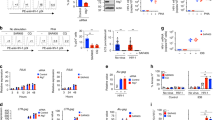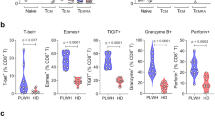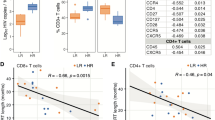Abstract
HIV-1 infection is characterized by a gradual loss of CD4+ T cells and progressive immune deficiency that leads to opportunistic infections, otherwise rare malignancies and ultimately death. Extensive research over the past two decades has increased our insight into the pathogenic mechanisms underlying these features of HIV-1 infection. Here, we will give a brief overview of the most recent findings and present a model that fits most of the relevant aspects of HIV-1 infection as known. We hypothesize that HIV-1 infection depletes T cell supplies (which are not replaced because of low and static thymic function) by direct infection and killing of cells and through hyperactivation of the immune system.
This is a preview of subscription content, access via your institution
Access options
Subscribe to this journal
Receive 12 print issues and online access
$209.00 per year
only $17.42 per issue
Buy this article
- Purchase on Springer Link
- Instant access to full article PDF
Prices may be subject to local taxes which are calculated during checkout


Similar content being viewed by others
References
Miedema, F., Tersmette, M. & Van Lier, R. A. W. AIDS pathogenesis: a dynamic interaction between HIV and the immune system. Immunol. Today 11, 293–297 (1990).
Miedema, F. Immunobiology of HIV infection: from latency and reactivation to protection and perturbation. The Immunologist 3, 228–230 (1995).
Meyaard, L. et al. Programmed death of T cells in HIV-1 infection. Science 257, 217–219 (1992).
Ho, D. D., Moudgil, T. & Alam, M. Quantification of human immunodeficiency virus type 1 in the blood of infected persons. N. Engl. J. Med. 321, 1621–1625 (1989).
Michael, N. L., Vahey, M., Burke, D. S. & Redfield, R. R. Viral DNA and mRNA expression correlate with the stage of human immunodeficiency virus (HIV) type 1 infection in humans: evidence for viral replication in all stages of HIV disease. J. Virol. 66, 310–316 (1992).
Steel, C. M. et al. HLA haplotype A1 B8 DR3 as a risk factor for HIV-related disease. Lancet 1, 1185–1188 (1988).
Simmonds, P. et al. Determinants of HIV disease progression: six-year longitudinal study in the Edinburgh haemophilia/HIV cohort. Lancet 338, 1159–1163 (1991).
Wei, X. et al. Viral dynamics in human immunodeficiency virus type 1 infection. Nature 373, 117–122 (1995).
Ho, D. D. et al. Rapid turnover of plasma virions and CD4 lymphocytes in HIV-1 infection. Nature 373, 123–126 (1995).
Wolthers, K. C. et al. T-cell telomere length in HIV-1 infection: no evidence for increased CD4+ T cell turnover. Science 274, 1543–1547 (1996).
Palmer, L. D. et al. Telomere length, telomerase activity, and replicative potential in HIV infection: analysis of CD4+ and CD8+ T cells from HIV-discordant monozygotic twins. J. Exp. Med. 185, 1381–1386 (1997).
Pakker, N. G. et al. Biphasic kinetics of peripheral blood T cells after triple combination therapy in HIV-1 infection: a composite of redistribution and proliferation. Nature Med. 4, 208–214 (1998).
Bucy, R. P. et al. Initial increase in blood CD4+ lymphocytes after HIV antiretroviral therapy reflects redistribution from lymphoid tissues. J. Clin. Invest. 103, 1391–1398 (1999).
Wolthers, K. C., Noest, A. J., Otto, S. A., Miedema, F. & De Boer, R. J. Normal telomere lengths in naive and memory CD4+ T cells in HIV-1 infection: a mathematical interpretation. AIDS Res. Hum. Retroviruses 15, 1053–1062 (1999).
Sachsenberg, N. et al. Turnover of CD4+ and CD8+ T lymphocytes in HIV-1 infection as measured by Ki-67 antigen. J. Exp. Med. 187, 1295–1303 (1998).
Fleury, S. et al. Limited CD4+ T-cell renewal in early HIV-1 infection: effect of highly active antiretroviral therapy. Nature Med. 4, 794–801 (1998).
Hazenberg, M. D. et al. T cell division in human immunodeficiency virus (HIV-1)-infection is mainly due to immune activation: a longitudinal analysis in patients before and during highly active anti-retroviral therapy. Blood 95, 249–255 (2000).
Fleury, S. et al. Long-term kinetics of T cell production in HIV-infected subjects treated with highly active anti-retroviral therapy. Proc. Natl Acad. Sci. USA 97, 5393–5398 (2000).
Mohri, H., Bonhoeffer, S., Monard, S., Perelson, A. S. & Ho, D. D. Rapid turnover of T lymphocytes in SIV-infected rhesus macaques. Science 279, 1223–1227 (1998).
Mohri, H. et al. Rapid turnover of T lymphocytes in HIV-1 infection and its reduction by HAART: a kinetic study using deuterated glucose. 7th Conference on Retroviruses and Opportunistic Infections, San Francisco (2000).
Wolthers, K. C., Schuitemaker, H. & Miedema, F. Rapid CD4+ T-cell turnover in HIV-1 infection: a paradigm revisited. Immunol. Today 19, 44–48 (1998).
Clark, D. R. et al. T-cell progenitor function during progressive human immunodeficiency virus-1 infection and after antiretroviral therapy. Blood 96, 242–249 (2000).
Vigano, A. et al. Thymus volume correlates with the progression of vertical HIV infection. AIDS 13, F29–F34 (1999).
McCune, J. M. et al. High prevalence of thymic tissue in adults with human immunodeficiency virus-1 infection. J. Clin. Invest. 101, 2301–2308 (1998).
Smith, K. Y. et al. Thymic size and lymphocyte restoration in patients with human immunodeficiency virus infection after 48 weeks of zidovudine, lamivudine, and ritonavir therapy. J. Infect. Dis. 181, 141–147 (2000).
Douek, D. C. et al. Changes in thymic function with age and during the treatment of HIV infection. Nature 396, 690–695 (1999).
Poulin, J.-F. et al. Direct evidence for thymic function in adult humans. J. Exp. Med. 190, 479–486 (1999).
Zhang, L. et al. Measuring recent thymic emigrants in blood of normal and HIV-1-infected individuals before and after effective therapy. J. Exp. Med. 190, 725–732 (1999).
Douek, D. C., Koup, R. A., McFarland, R. D., Sullivan, J. L. & Luzuriaga, K. Effect of HIV on thymic function before and after antiretroviral therapy in children. J. Infect. Dis. 181, 1479–1482 (2000).
Hatzakis, A. et al. Effect of recent thymic emigrants on progression of HIV-1 disease. Lancet 355, 599–604 (2000).
Livak, F. & Schatz, D. G. T-cell receptor alpha locus V(D)J recombination by-products are abundant in thymocytes and mature T cells. Mol. Cell. Biol. 16, 609–618 (1998).
Breit, T. M., Verschuren, M. C. M., Wolvers-Tettero, I. L. M., Van Gastel-Mol, E. J. & Van Dongen, J. J. M. Human T cell leukemias with continuous V(D)J recombinase activity for TCR-δ gene deletion. J. Immunol. 159, 4341–4349 (1997).
Hazenberg, M. D. et al. Increased cell division but not thymic dysfunction rapidly affects the TREC content of the naive T cell population in HIV-1 infection. Nature Med. 6, 1036–1042 (2000).
Messele, T. et al. Reduced naive and increased activated CD4 and CD8 cells in healthy adult Ethiopians compared with their Dutch counterparts. J. Clin. Exp. Immunol. 115, 443–450 (1999).
Chun, T-W. et al. Quantification of latent tissue reservoirs and total body viral load in HIV-1 infection. Nature 387, 183–187 (1997).
Embretson, J. et al. Analysis of human immunodeficiency virus-infected tissues by amplification and in situ hybridization reveals latent and permissive infections at single-cell resolution. Proc. Natl Acad. Sci. USA 90, 357–361 (1993).
Clark, D. R., De Boer, R. J., Wolthers, K. C. & Miedema, F. T cell dynamics in HIV-1 infection. Adv. Immunol. 73, 301–327 (1999).
Gruters, R. A. et al. Immunological and virological markers in individuals progressing from seroconversion to AIDS. AIDS 5, 837–844 (1991).
Roederer, M. et al. CD8 naive T cell counts decrease progressively in HIV-infected adults. J. Clin. Invest. 95, 2061–2066 (1995).
Rabin, R. L., Roederer, M., Maldonado, Y., Petru, A. & Herzenberg, L. A. Altered representation of naive and memory CD8 T cell subsets in HIV-infected children. J. Clin. Invest. 95, 2054–2060 (1995).
Swingler, S. et al. HIV-1 Nef mediates lymphocyte chemotaxis and activation by infected macrophages. Nature Med. 5, 997–1003 (1999).
Mahalingam, M. et al. T cell activation and disease severity in HIV infection. Clin. Exp. Immunol. 93, 337–343 (1993).
Sprent, J. Lifespan of naive, memory and effector lymphocytes. Curr. Opin. Immunol. 5, 433–438 (1993).
Rosenzweig, M. et al. Increased rates of CD4+ and CD8+ T lymphocyte turnover in simian immunodeficiency virus-infected macaques. Proc. Natl Acad. Sci. USA 95, 6388–6393 (1998).
McCune, J. M. et al. Factors influencing T cell turnover in HIV-1-seropositive patients. J. Clin. Invest. 105, R1–R8 (2000).
Grossman, Z. et al. T cell turnover in SIV infection. Science 284, 555 (1999).
Grossman, Z. & Herberman, R. B. T-cell homeostasis in HIV-1 infection is neither failing nor blind: modified cell counts reflect an adaptive response of the host. Nature Med. 3, 486–490 (1997).
Unutmaz, D., Pileri, P. & Abrignani, S. Antigen-independent activation of naive and memory resting T cells by a cytokine combination. J. Exp. Med. 180, 1159–1164 (1994).
Giorgi, J. V. et al. Shorter survival in advanced human immunodeficiency virus type 1 infection is more closely associated with T lymphocyte activation than with plasma virus burden or virus chemokine coreceptor usage. J. Infect. Dis. 179, 859–870 (1999).
Marlink, R. et al. Reduced rate of disease development after HIV-2 infection as compared to HIV-1. Science 265, 1587–1590 (1994).
Michel, P. et al. Reduced immune activation and T cell apoptosis in human immunodeficiency virus type 2 compared with type 1: correlation of T cell apoptosis with β2 microglobulin concentration and disease evolution. J. Infect. Dis. 181, 64–75 (2000).
Chakrabart, L. A. et al. Normal T cell turnover in sooty mangabeys harboring active simian immunodeficiency virus infection. J. Virol. 74, 1209–1223 (2000).
Hazenberg, M. D., Clark, D. R. & Miedema, F. Tilted balance of T cell renewal in HIV-1 infection. AIDS Rev. 1, 67–73 (1999).
Haynes, B. F., Markert, M. L., Sempowski, G. D., Patel, D. D. & Hale, L. P. The role of the thymus in immune reconstitution in aging, bone marrow transplantation, and HIV-1 infection. Ann. Rev. Immunol. 18, 529–560 (2000).
Rep, M. et al. Treatment with depleting CD4 monoclonal antibody results in a preferential loss of circulating naive T cells but does not affect IFN-γ secreting TH1 cells in humans. J. Clin. Invest. 99, 2225–2231 (1997).
Mackall, C. L. et al. Age, thymopoiesis, and CD4+ T-lymphocyte regeneration after intensive chemotherapy. N. Engl. J. Med. 332, 143–149 (1995).
George, A. J. T. & Ritter, M. A. Thymic involution with ageing: obsolescence or good housekeeping? Immunol. Today 17, 267–272 (1996).
Hong, R. The DiGeorge anomaly. Immunodefic. Rev. 3, 1–14 (1991).
Cohen Stuart, J. W. T. et al. Early recovery of CD4+ T lymphocytes in children on highly active antiretroviral therapy. AIDS 12, 2155–2159 (1998).
Franco, J. M. et al. CD4+ and CD8+ T lymphocyte regeneration after anti-retroviral therapy in HIV-1 infected children and adult patients. Clin. Exp. Immunol. 119, 493–498 (2000).
Vigano, A. et al. Early immune reconstitution after potent antiretroviral therapy in HIV-infected children correlates with the increase in thymus volume. AIDS 14, 251–261 (2000).
De Vries, E. et al. Reconstitution of lymphocyte subpopulations after paediatric bone marrow transplantation. Bone Marrow Transplant. 25, 267–275 (2000).
Van Rossum, A. M. C. et al. Immune reconstitution in HIV-1 infected children treated with highly active antiretroviral therapy is independent of their age and pretreatment immune status. (Submitted, 2000).
Schuitemaker, H. et al. Biological phenotype of human immunodeficiency virus type 1 clones at different stages of infection: progression of disease is associated with a shift from monocytotropic to T-cell-tropic virus populations. J. Virol. 66, 1354–1360 (1992).
Blaak, H. et al. In vivo HIV-1 infection of CD45RA+CD4+ T cells is established primarily by syncytium-inducing variants and correlates with the rate of CD4+ T cell decline. Proc. Natl Acad. Sci. USA 97, 1269–1274 (2000).
Kaneshima, H. et al. Rapid-high, syncytium-inducing isolates of human immunodeficiency virus type 1 induce cytopathicity in the human thymus of SCID-hu mouse. J. Virol. 68, 8188–8192 (1994).
Kitchen, S. G., Uittenboogaart, C. H. & Zack, J. A. Mechanism of human immunodeficiency virus type 1 localization in CD4-negative thymocytes: differentiation from a CD4-positive precursor allows productive infection. J. Virol. 71, 5713–5722 (1997).
Koot, M. et al. Prognostic value of human immunodeficiency virus type 1 biological phenotype for rate of CD4+ cell depletion and progression to AIDS. Ann. Intern. Med. 118, 681–688 (1993).
Rosenberg, E. S. et al. Vigorous HIV-1 specific CD4+ T cell responses associated with control of viremia. Science 278, 1447–1450 (1997).
Kalams, S. A. et al. Association between virus-specific cytotoxic T-lymphocyte and helper responses in human immunodeficiency virus type-1 infection. J. Virol. 73, 6715–6720 (1999).
Pontesilli, O. et al. Longitudinal analysis of human immunodeficiency virus type-1 (HIV-1) specific cytotoxic T lymphocyte responses: a predominant gag-specific response is associated with non-progressive infection. J. Infect. Dis. 178, 1008–1018 (1998).
Pantaleo, G. et al. HIV infection is active and progressive in lymphoid tissue during the clinically latent stage of disease. Nature 362, 355–358 (1993).
Connors, M. et al. HIV infection induces changes in CD4+ T-cell phenotype and depletions within the CD4+ T cell repertoire that are not immediately restored by antiviral or immune-based therapies. Nature Med. 3, 533–540 (1997).
Kostense, S. et al. Diversity of the T cell receptor BV repertoire in HIV-1 infected patients reflects the biphasic CD4+ T-cell repopulation kinetics during highly active antiretroviral therapy. AIDS 12, F235–F240 (1998).
Haase, A.T. Population biology of HIV-1 infection: viral and CD4+ T cell demographics and dynamics in lymphatic tissues. Annu. Rev. Immunol. 17, 625–656 (1999).
Hellerstein, M. K. & McCune, J. M. T cell turnover in HIV-1 disease. Immunity 7, 583–589 (1997).
Acknowledgements
We thank Z. Grossman, R. van Lier, R. van Rij and R. de Boer for reading the manuscript.
Author information
Authors and Affiliations
Corresponding author
Rights and permissions
About this article
Cite this article
Hazenberg, M., Hamann, D., Schuitemaker, H. et al. T cell depletion in HIV-1 infection: how CD4+ T cells go out of stock. Nat Immunol 1, 285–289 (2000). https://doi.org/10.1038/79724
Issue Date:
DOI: https://doi.org/10.1038/79724
This article is cited by
-
mRNA vaccine boosters and impaired immune system response in immune compromised individuals: a narrative review
Clinical and Experimental Medicine (2024)
-
The role of CD38 in HIV infection
AIDS Research and Therapy (2021)
-
Single-cell tracking of flavivirus RNA uncovers species-specific interactions with the immune system dictating disease outcome
Nature Communications (2017)
-
Critical roles for Akt kinase in controlling HIV envelope-mediated depletion of CD4 T cells
Retrovirology (2013)
-
HIV integration and T cell death: additional commentary
Retrovirology (2013)



